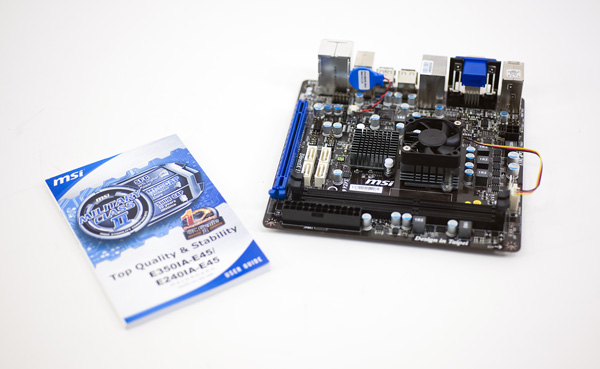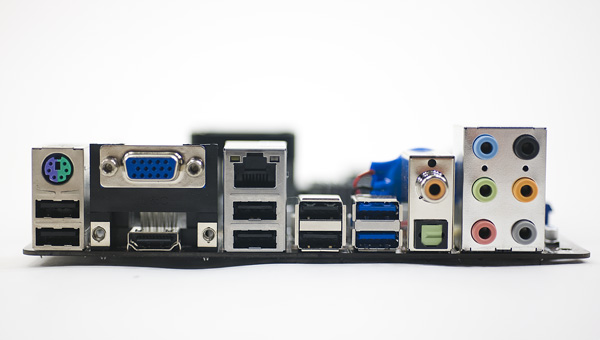The Brazos Review: AMD's E-350 Supplants ION for mini-ITX
by Anand Lal Shimpi on January 27, 2011 6:08 PM ESTThe Price: Around $100, The Motherboard: MSI's E350IA-E45
AMD expects most E-350 motherboards to sell for around $100 in etail. For lightly featured boards, I've heard this estimate is about right. It's once you start adding WiFi, passive cooling and other enhancements that costs creep up to around $130. Even at $130 that's not a bad deal. We're talking about better pricing than most ION boards but with much better performance.
AMD sent over the first Brazos motherboard ready for prime time, MSI's E350IA-E45. The mini-ITX board features two DDR3 DIMM slots (a Brazos feature, there's still only one 64-bit memory channel off of the APU), four 6Gbps SATA ports and a PCIe x16 slot (electrically x4). On the I/O panel MSI provides both VGA and HDMI out for video. For audio you have the options of running audio over HDMI, coax, optical or 1/8" stereo outputs. There are a surprising number of USB ports on the back of the board: 6 x USB 2.0 and 2 x USB 3.0 driven off of the very familiar NEC D7202 USB 3.0 controller. There are two USB 2.0 headers for front panel or case USB as well. There's unfortunately no WiFi support on board, all you get is a single Realtek RTL8111D 10/100/1000 ethernet port.

mini-ITX motherboard (right) and mini-ITX manual (left)
The MSI board doesn't support overclocking, so all results are at the CPU's stock 1.6GHz frequency.
Power is supplied by a standard 24-pin ATX PSU connector (older Atom/ION boards sometimes only used a 20-pin connector) as well as a 4-pin ATX12V connector. The Hudson FCH is passively cooled while the APU features a small, and unfortunately audible fan. ASUS is working on a passively cooled E-350 motherboard which I should have within the next week.























176 Comments
View All Comments
DanaG - Friday, January 28, 2011 - link
One thing I'm wondering: how does Brazos compare to Atom and ARM (such as QNAP TS-219P+) on power usage and network performance? From reviews of ARM devices, it looks like they hit a speed limit that may be caused by the SoC devices themselves.I do know that Realtek Gigabit Ethernet sucks, so it'd be worthwhile to benchmark with an Intel NIC and a Broadcom NIC, as well.
Aone - Friday, January 28, 2011 - link
I reckon Anand Lal Shimpi should know that neither Atom D510 nor Atom 330 supports EIST or Idle Power State. If he does compare the power consumtion he, at least, must mention it.And i'm not sure that Atom platform supports DDR3-1333 as Brazos. Usually Atom sticks with DDR2-667.
Unfortunately, mem config is absent from description of test configs.
DanNeely - Friday, January 28, 2011 - link
DDR3-800 based atoms launched a few months back; the performance difference vs their DDR2 siblings was negligible.krish123 - Friday, January 28, 2011 - link
Hi Anand,You are comparing the gaming performance of Core I5 2500K / higher clocked graphics with E350, but u should also show the power consumption/price difference on those parts. .. I feel ., kind of biased review, when you are trying to compare only the positive side of intel parts and not the negative side
I will wait for your review on Llano and bulldozer
Regards,
Kicha
7Enigma - Friday, January 28, 2011 - link
Did you even read the text or just look at the pretty graphs?The i5 is in there as a bracketing agent so that those of us with desktop systems can get a feel for the performance difference to these Atom/APU products. There was never a direct comparison drawn unless you ignore all the text and just stare at the pictures.
OneArmedScissorB - Friday, January 28, 2011 - link
Did you even read the pretty graphs? They were very nearly neck and neck in those comparisons. Why omit the most significant differentiation between the two?Sandy Bridge and Bobcat as HTPC platforms are more comparable than anything else. They are both at least "good enough" for general use, have similar IGP and video acceleration capabilities, and are both readily available in mini-ITX.
And yet, there's a 3.1 GHz Athlon II X2 with an 890GX board in the power results, likely full size ATX, in place of every single last one of the numerous mini-ITX platforms they could have just copied and pasted into the chart from past articles. Wtfbbq?!?
That was not just an oversight, but a very significant mistake that detracts from the usefulness of the entire article.
bjacobson - Saturday, January 29, 2011 - link
hm, that seems a bit of an overstatement. I don't really see how the 2500's are at all in the same market as this.code65536 - Friday, January 28, 2011 - link
I wonder, does Bobcat support hardware-assisted virtualization?silverblue - Friday, January 28, 2011 - link
I read that it does.macs - Friday, January 28, 2011 - link
Can someone test the power consumption of an i3 2100 on itx mobo? I suppose it will be quite close to brazos, at idle at least